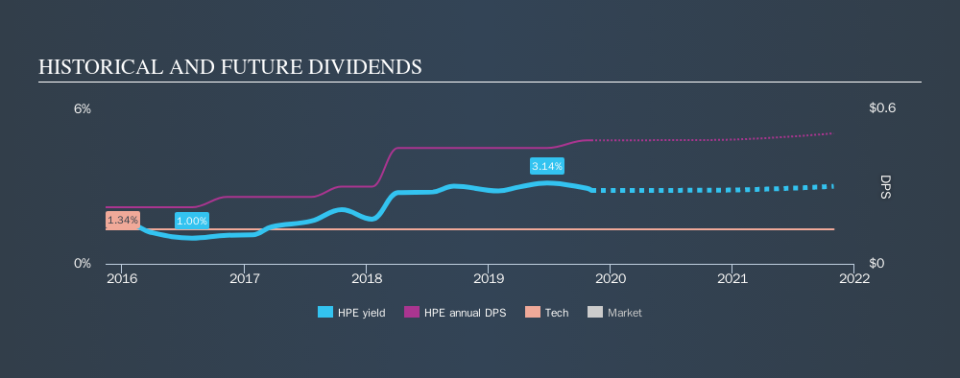Consider This Before Buying Hewlett Packard Enterprise Company (NYSE:HPE) For The 2.9% Dividend

Is Hewlett Packard Enterprise Company (NYSE:HPE) a good dividend stock? How can we tell? Dividend paying companies with growing earnings can be highly rewarding in the long term. Yet sometimes, investors buy a popular dividend stock because of its yield, and then lose money if the company's dividend doesn't live up to expectations.
With a 2.9% yield and a four-year payment history, investors probably think Hewlett Packard Enterprise looks like a reliable dividend stock. While the yield may not look too great, the relatively long payment history is interesting. The company also bought back stock during the year, equivalent to approximately 13% of the company's market capitalisation at the time. Some simple research can reduce the risk of buying Hewlett Packard Enterprise for its dividend - read on to learn more.
Explore this interactive chart for our latest analysis on Hewlett Packard Enterprise!
Payout ratios
Dividends are typically paid from company earnings. If a company pays more in dividends than it earned, then the dividend might become unsustainable - hardly an ideal situation. As a result, we should always investigate whether a company can afford its dividend, measured as a percentage of a company's net income after tax. Although it reported a loss over the past 12 months, Hewlett Packard Enterprise currently pays a dividend. When a company recently reported a loss, we should investigate if its cash flows covered the dividend.
Hewlett Packard Enterprise paid out 69% of its cash flow as dividends last year, which is within a reasonable range for the average corporation.
Is Hewlett Packard Enterprise's Balance Sheet Risky?
Given Hewlett Packard Enterprise is paying a dividend but reported a loss over the past year, we need to check its balance sheet for signs of financial distress. A quick check of its financial situation can be done with two ratios: net debt divided by EBITDA (earnings before interest, tax, depreciation and amortisation), and net interest cover. Net debt to EBITDA measures total debt load relative to company earnings (lower = less debt), while net interest cover measures the ability to pay interest on the debt (higher = greater ability to pay interest costs). With net debt of 1.72 times its EBITDA, Hewlett Packard Enterprise has an acceptable level of debt.
Net interest cover can be calculated by dividing earnings before interest and tax (EBIT) by the company's net interest expense. Hewlett Packard Enterprise has interest cover of more than 12 times its interest expense, which we think is quite strong.
We update our data on Hewlett Packard Enterprise every 24 hours, so you can always get our latest analysis of its financial health, here.
Dividend Volatility
Before buying a stock for its income, we want to see if the dividends have been stable in the past, and if the company has a track record of maintaining its dividend. Looking at the data, we can see that Hewlett Packard Enterprise has been paying a dividend for the past four years. The dividend has not fluctuated much, but with a relatively short payment history, we can't be sure this is sustainable across a full market cycle. During the past four-year period, the first annual payment was US$0.22 in 2015, compared to US$0.48 last year. This works out to be a compound annual growth rate (CAGR) of approximately 22% a year over that time.
We're not overly excited about the relatively short history of dividend payments, however the dividend is growing at a nice rate and we might take a closer look.
Dividend Growth Potential
While dividend payments have been relatively reliable, it would also be nice if earnings per share (EPS) were growing, as this is essential to maintaining the dividend's purchasing power over the long term. Over the past five years, it looks as though Hewlett Packard Enterprise's EPS have declined at around 11% a year. With this kind of significant decline, we always wonder what has changed in the business. Dividends are about stability, and Hewlett Packard Enterprise's earnings per share, which support the dividend, have been anything but stable.
Conclusion
When we look at a dividend stock, we need to form a judgement on whether the dividend will grow, if the company is able to maintain it in a wide range of economic circumstances, and if the dividend payout is sustainable. We're not keen on the fact that Hewlett Packard Enterprise paid dividends despite reporting a loss over the past year, although fortunately its dividend was covered by cash flow. Earnings per share have been falling, and the company has a relatively short dividend history - shorter than we like, anyway. In this analysis, Hewlett Packard Enterprise doesn't shape up too well as a dividend stock. We'd find it hard to look past the flaws, and would not be inclined to think of it as a reliable dividend-payer.
Without at least some growth in earnings per share over time, the dividend will eventually come under pressure either from costs or inflation. Businesses can change though, and we think it would make sense to see what analysts are forecasting for the company.
Looking for more high-yielding dividend ideas? Try our curated list of dividend stocks with a yield above 3%.
We aim to bring you long-term focused research analysis driven by fundamental data. Note that our analysis may not factor in the latest price-sensitive company announcements or qualitative material.
If you spot an error that warrants correction, please contact the editor at editorial-team@simplywallst.com. This article by Simply Wall St is general in nature. It does not constitute a recommendation to buy or sell any stock, and does not take account of your objectives, or your financial situation. Simply Wall St has no position in the stocks mentioned. Thank you for reading.

 Yahoo Finance
Yahoo Finance 
